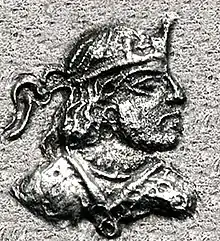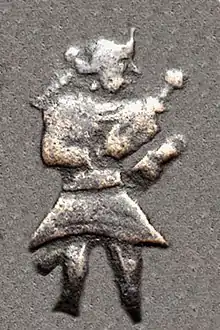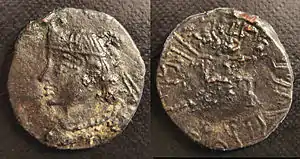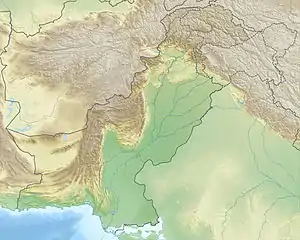Paratarajas
The Pāratarajas was a dynasty of Parthian kings, and ruling family from what is now Pakistan, from the 1st century to the 3rd century. The seat of their capital was Balochistan.


The Pāratas are thought to be identical with the Pārthava of Iranian literature, the Parthians of Greek literature, and the Pāradas of Indian literature.[3]
History
Based on ancient sources, the Paratas may have originated in northwestern Iran, northern Iraq or even eastern Turkey, roughly in the areas where Kurds live today, around the 7th century BCE.[4] They then migrated, so that Alexander the Great encountered them in the area of Bactria and Sogdiana.[4] They then moved through Seistan to reach Baluchistan in the 1st century CE, where they settled, first on the coast, and then in the interior.[4] Indian sources also locate them in the same general area, beyond the Indus river.[4]
The Paratarajas must have maintained a strong interaction with their neighbors to the West (the Indo-Parthians), and their neighbors to the east (the Western Satraps), perhaps having a role of intermediary.[5] The presence of the Paratarajas in Baluchistan suggests that the Kushans did not rule in that area.[5]
It seems that the Paratarajas fell into the orbit of the Sasanian Empire circa 262 CE, in light of a Naqsh-i-Rustam inscription of 262 CE stating that "P'rtu" (between Makran and Hindustan, that is, eastern Baluchistan) became one of the provinces of the Sasanian Empire. The Paratas may have been submitted by the Sasanians around the time of Ardeshir I or more probably Shapur I.[6]
From a linguistic standpoint, the Baluchi language belongs to the Iranian group of Indo-European languages, and is most closely related to Kurdish, whose locutors live today in the area from which the Paratas seem to have originally immigrated. This raises the possibility that today's Baluchis are somehow descendants of the Paratas.[7]
Numismatics

Obv: Robed bust of Bhimarjuna left, wearing tiara-shaped diadem.
Rev: Swastika with Kharoshthi legend surrounding: Yolatakhmaputrasa Parataraja Bhimarjunasa ("Of the Parataraja Bhimarjuna, son of Yolatakhma"). From Loralai Pakistan.
1.70g. Senior (Indo-Scythian) 286.1 (Bhimajhuna), since corrected to Bhimarjuna by H. Falk [8]

The Pāratas, an Iranian people and ruling dynasty from what is now western Pakistan, are known essentially through their coinage, which typically exhibit the bust of a particular monarch on the obverse (having long hair within a headband), and a swastika within a circular legend on the reverse in Kharoshthi (usually copper coins) and sometimes in Brahmi (usually silver coins).[9] Coins depicting Pārata monarchs have been found in and around the district of Loralai, Balochistan, western Pakistan. This was the seat of their capital.
Many similarities have been noted between Parataraja and Indo-Parthian coinage, as well as with the coinage of the Western Satraps, who were roughly contemporary and contiguous to the Paratarajas.[10]
Most of the names of kings on Parataraja suggest an Iranian origin.[5]
Classical and historical sources
In about 440 BCE, the Greek historian Herodotus described the Paraitakenoi as a tribe ruled by Deiokes, a Median monarch who ruled on northwestern Persia. (History I.101).[6]
Strabo in his Geographica places the "Paraitakai" in northern Iraq and western Persia (Geography XI, XV and XVI).[6] Arrian described how Alexander the Great encountered the Pareitakai in Bactria and Sogdiana, and had Craterus conquer them (Anabasis Alexandrou IV).[6]
According to Isidore of Charax, the geographical area beyond Sakastene is called "Paraitakene", corresponding to modern Baluchistan and Seistan, possibly their new territory from that time (25-1 BCE).[6]
The Periplus of the Erythraean Sea (1st century CE) describes the territory of the Paradon beyond the Ommanitic region, on the coast of Balochistan.[6]
According to a Naqsh-i-Rustam inscription of 262 CE, "P'rtu" (between Makran and Sindh, became one of the provinces of the Sasanian Empire. The Paratas may have been submitted by the Sasanians around the time of Ardeshir I or more probably Shapur I.[6]
In the Paikuli inscription from the time of Sasanian ruler Narseh (293-302), the "Paradanshah" congratulates Narseh on his victory over Bahram III.[6]
Rulers
The Paratarajas rulers were as follows:[11]
- Yolamira, son of Bagareva (c. 125–150 CE)
- Bagamira, son of Yolamira (c. 150 CE)
- Arjuna, a second son of Yolamira (c. 150–160 CE)
- Hvaramira, a third son of Yolamira (c. 160–175 CE)
- Mirahvara, son of Hvaramira (c. 175–185 CE)
- Miratakhma, another son of Hvaramira (c. 185–200 CE)
- Kozana, son of Bagavharna (and perhaps grandson of Bagamira?) (c. 200–220 CE)
- Bhimarjuna, son of Yolatakhma (and perhaps grandson of Arjuna?) (c. 220–235 CE)
- Koziya, son of Kozana (c. 235–265 CE)
- Datarvharna, son of Datayola I (and perhaps grandson of Bhimarjuna?) (c. 265–280 CE)
- Datayola II, son of Datarvharna (c. 280–300 CE)
References
- CNG Coins
- CNG Coins
- New light on the Paratarajas, Pankaj Tandon p11
- "New light on the Paratarajas" Pankaj Tandon p.30ff
- "New light on the Paratarajas" Pankaj Tandon p.37
- "New light on the Paratarajas" Pankaj Tandon p29-30
- The Baluchi language "is classified as a member of the Iranian group of the Indo-European language family, which includes Farsi (Persian), Pushtu, Baluchi, and Kurdish. Baluchi is closely related to only one of the members of the Iranian group, Kurdish": see Selig S. Harrison, In Afghanistan’s Shadow: Baloch Nationalism and Soviet Temptations (Washington: Carnegie Endowment for International Peace, 1981) quoted in "New light on the Paratarajas" Pankaj Tandon p.31 Note 35
- Falk, H. "The names of the Paratarajas issuing coins with Kharosthi legends", Numismatic Chronicle, 2007: 171-178.
- New Light on the Pāratarājas, by Pankaj Tandon p.1
- "New light on the Paratarajas" Pankaj Tandon p.35
- Further Light on the Paratarajas
Sources
- Tandon, P. "New light on the Paratarajas", Numismatic Chronicle, 2006. Pdf
- Falk, H. "The names of the Paratarajas issuing coins with Kharosthi legends", Numismatic Chronicle, 2007: 171-178.
- Tandon, P. "Further light on the Paratarajas", Numismatic Chronicle, 2009. Pdf
- Schindel, Nikolaus (2016). "The Coinages of Paradan and Sind in the Context of Kushan and Kushano-Sasanian Numismatics". In Curtis, Vesta Sarkhosh; Pendleton, Elizabeth J.; Alram, Michael; Daryaee, Touraj (eds.). The Parthian and Early Sasanian Empires: Adaptation and Expansion. Oxbow Books. ISBN 9781785702082.
